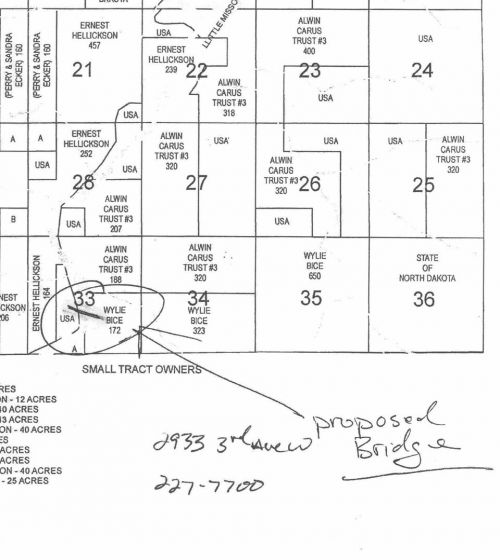Last Word | August 22nd, 2018

The Bismarck Tribune’s Amy Dalrymple’s wrote a good story recently about a marathon Little Missouri Scenic River Commission meeting. I’m going to write more about that later. I’ll just say, for now, be careful what you wish for.
What I’m writing about now is one of the things the Commission discussed—the illegal bridge over the Little Missouri State Scenic River on the Wylie Bice Ranch in Dunn County.
I’ve written about this a few times, but there are new developments and I’m going to address it one more time—for now.
Wylie Bice is the uber-rich rancher from west of Killdeer, the man who built a trucking company from scratch and sold it for at least $79.9 million. Higher numbers have been bandied about, but we know from business journal reports he got at least that much. He’s a real North Dakota success story. Good for him.
He may have had some debt to pay off with the proceeds, but he had enough left over to buy a neighbor’s ranch, giving him land on both sides of the Little Missouri State Scenic River.
He needed to get back and forth, so he built a bridge—a mighty expensive bridge, probably a couple million dollars worth—and put one end of it on land he didn’t own. It took a few years for the owners—the U.S. Government’s Bureau of Land Management—to find out about it, and when they did, they did what government agencies do: they set out to do a study to determine what to do about Mr. Bice’s transgressions.
That study is underway right now, after a brief public comment period. What the BLM has done is required Mr. Bice to submit an application to build a bridge on their land (a bridge that already exists). He’s done that. Now they’re requiring an Environmental Assessment, which Mr. Bice will have to pay for.
The Environmental Assessment could be done yet this fall. It will lay out a series of alternatives, which could include tearing down the bridge, or granting an easement and leaving the bridge in place, or a new option that just surfaced recently—selling the land the bridge is on to Mr. Bice. It’s only about 80 acres, and it’s isolated from other BLM land holdings in Dunn County, and it’s certainly worth less than $79.9 million, so Mr. Bice can afford it.
But it’s looking more and more like Mr. Bice is not the kind of man you want to do business with. For one thing, he’s a liar.
In Amy Dalrymple’s Tribune story was this line:
“Bice said he believed he owned the property and he chose the location to avoid removing a lot of trees.”
That’s the lie.
Although he didn’t contact the BLM about putting a bridge on their land, he certainly knew it was on their land.
You see, Mr. Bice (or his engineer) did one thing right: they applied for a permit from the U.S. Army Corps of Engineers to put a bridge over the river, for which the Corps has management responsibilities. The Corps is only responsible for the river itself, though, not the river bank. Mr. Bice owned the land on one side of the river and the BLM the other.
In his application to the corps, Mr. Bice put in photocopies of two maps of the area. Both clearly show the land on the west side of the river is owned by the federal government. He even drew in the bridge on both maps, from his land onto BLM land. This map, from the Dunn County Atlas, with his note on the bottom showing the location of his bridge.
There's a second map in the application, from the U. S. Forest Service's National Grasslands map, but I won't bother you with it.
So it is pretty obvious he knew he was putting a bridge where he shouldn’t be putting a bridge, at least without permission from the people who owned the land. Still, the excuse he used for building the bridge where it shouldn't be, when questioned by the Tribune reporter, was that he thought he owned it.
Sorry, Mr. Bice, you’re busted.
I got my copy of the Corps permit application a year ago by sending an email to the Bismarck office of the Corps of Engineers on July 1, 2017, which said:
“I am interested in finding out whether a permit was issued to Wylie Bice, Grassy Butte, ND, to construct a bridge over the little Missouri in Dunn County, North Dakota. The legal address is Section 33, Township 148 North, Range 97 West. If so, I would like to see the permit and any accompanying documents related to the project. The bridge was likely built in the last five years. Thank you.”
Just two days later, on July 3, I got this response from a nice lady at the Corps office, along with a copy of the permit application and the letter approving the permit:
“Mr. Bice obtained a nationwide permit to install a bridge in 2013. Attached is the verification letter and application information. The project manager that worked on this has since retired, so if you have any questions, feel free to give me a call.”
Well, I read the application and the letter approving it, and looked at the maps, and saw that the west side of the bridge was on BLM land. So I wrote back:
“Thank you for sending me that information. I have just one more question. The bridge enters/exits the Little Missouri River on the north side on BLM land. Does your permit cover access to the BLM land as well as authorizing the bridge? Or would that need a second permit?”
The nice lady at the Corps wrote right back:
“Our permit is not a land right. By signing our permit application, the applicant is providing assurance that he/she has the authority to construct the project as presented in the application.”
Well, that settles that, then. I also found this language in the letter approving the bridge:
“Dear Mr. Bice . . . You may proceed with your project in accordance with the terms and conditions of DA Nationwide Permit No, 14 . . . This determination is applicable only to the permit program administered by the Corps of Engineers. It does not eliminate the need to obtain other Federal, state, tribal, and local approvals before beginning work.”
In other words, Mr. Bice, you probably should go knock on the BLM manager’s door and ask him if it is okay to put a bridge on his land.
I did follow up with a phone call to the Corps lady, just to confirm. She said it was the responsibility of the person doing the project to contact the BLM. She said they assumed he had done that--it would only make sense to get permission before building the bridge.
So if you read the Tribune story, and Mr. Bice’s statement that he thought he owned the land, and thought to yourself, “Well, anybody can make a mistake,” well WRONG. He knew exactly what he was doing.
Well, after that exchange with the Corps, I called the BLM office and asked what the heck was going on. They were surprised. They said they'd get back to me. They did. With this response "Well, we've got a situation here."
No sh*t, Sherlock.
So now I expect Mr. Bice to make a nice generous offer to the BLM for the land, and hope they will accept it and just go away. I suppose that’s the most logical solution. But I hope that’s not what happens. That’s just not right. Just because you have A LOT of money, you shouldn’t be able to get away with something like this. It just leaves a bad taste.
My suggestion is a hefty fine (although that won’t bother him either), grant him an easement for the bridge and the road to it, charge him back rent for the easement and rent going forward, and make him clean up the area around the bridge, get rid of his water depot, and reclaim the grassland where he planted alfalfa. This IS public land, land we all own.
So where the whole thing stands right now is, the BLM is considering five options:
I actually really prefer Number 2, tearing the damn thing down, but it probably just doesn't make sense to do that now that it is there. I wouldn't mind if a lot of people suggested that, though.
We’ll get a chance to comment on the Environmental Assessment and make our recommendations when it is done. I’ll let you know when that time comes.
June 19th 2025
June 19th 2025
April 27th 2025
April 17th 2025
February 28th 2025
_(1)__293px-wide.jpg)

__293px-wide.jpg)


